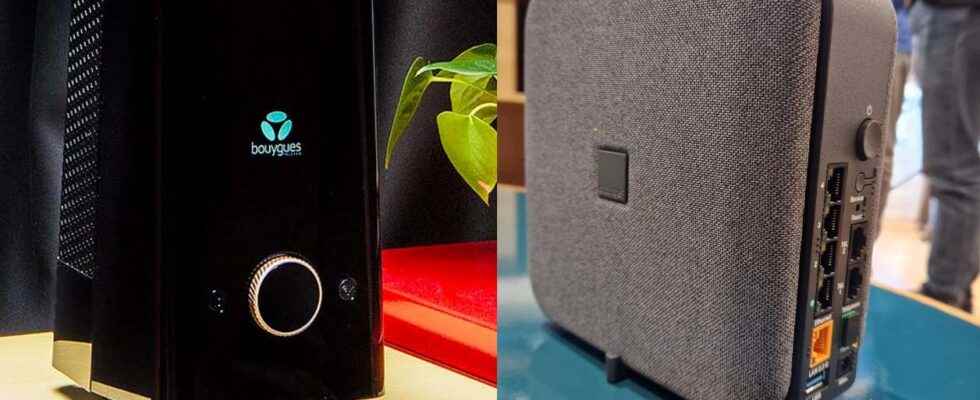There are now two high-end Wi-Fi 6E compatible boxes on the French market. These are the Livebox 6 from Orange, marketed on April 7, and the new version of the Bbox Fiber from Bouygues Telecom, which will be officially available from April 25.
The internet box
Let’s start with the famous Wi-Fi. The Livebox 6 was designed from the outset for the latest Wi-Fi 6E evolution. This is not the case with the Bbox Fiber released more than two years ago and which was therefore only compatible with Wi-Fi 6 originally.
However, Bouygues Telecom had planned the coup with a scalable product. He thus contented himself with changing the Wi-Fi card of his modem to make it tri-band. Wi-Fi 6E is in fact only a simple evolution of Wi-Fi 6 which allows you to take advantage of the 6 GHz frequency band, in addition to 2.4 and 5 GHz. There is therefore no reason to fear lower performance on the side of Bouygues Telecom.
Also see video:
Up to three repeaters are supplied with the Livebox 6, two with the Bbox.
The two Internet boxes are based on GPON fiber optic technology, unlike SFR which moved to a more recent and powerful standard at the start of the year with the SFR Box 8X.
Downstream speeds are 2 Gbits/s for Orange and Bouygues Telecom. On the other hand, the upstream speed is slightly higher with the Livebox 6 which peaks at 800 Mbits/s against 600 Mbits/s for the Bbox. But nothing prevents Bouygues from boosting its upload. It is even to be expected that it will align with Orange’s offer.
On the side of the incumbent operator, there is a 2.5 Gbit/s Ethernet port and four 1 Gbit/s ports. At its competitor, there is a port at 10 Gbit/s and four at 1 Gbit/s, but the commercial offer does not yet allow you to take advantage of 10 Gbit/s at the exit of the box.
However, it is a good way to ensure that the machine connected via this port (or the router) will benefit, now and in the future, from the best connection to the Net.
The TV box and the services included
The Livebox 6 does not come with a new TV decoder. It is accompanied by the UHD 4K TV box, which allows 300 hours of recording. The fiber Bbox is available with the 4K TV HDR Decoder which was launched on February 28th. It is an Android box that is based on the Google application universe. It includes up to 100 hours of recording.
Orange’s Replay Max feature provides access to delayed linear television programs for 24 months, as well as MyTF1 Max and 6playMax HD without advertising. There is no specific advantage with the Bouygues decoder, apart from free access to Salto for six months.
A second decoder or a TV key can be provided on request from Orange, which is not the case with Bouygues.
A 4G Airbox router of 20 GB per month is also included with the Livebox 6. A 4G key is also available from Bouygues but offered only while the box is activated or in the event of a problem and moving house.
Calls are unlimited from landlines to mobiles in Europe for both operators. Orange also includes those to the USA and Canada.
The Livebox 6 is the most expensive box on the market
The Livebox 6 is marketed via a new Livebox offer which costs 34.99 euros per month for the first year for new customers, then 54.99 euros. Former subscribers must immediately pay the 54.99 euros per month to take advantage of it.
The Bbox Fiber is accessible with the Bbox Ultym offer at 28.99 euros per month the first year, then 46.99 euros per month. Eight euros difference, that’s quite a difference.
And this is the main criticism that can be made of Orange. Its new Livebox 6 is the most expensive on the market. It even finds itself four euros above the SFR Box 8X which already peaked at 50 euros per month.
In conclusion, we can say that from a strictly technical point of view, the two boxes are close. With a slight advantage to the Livebox 6 for its uplink speed of 800 Mbit/s. Orange is also putting more additional services on the table in its commercial offer. Is that enough to justify such a price difference? On paper, one would be tempted to say no. We should see the differences in use.
But we feel that we find ourselves on an upward trend in the prices of fiber optic boxes. After conceding commercial gestures to convince subscribers to adopt this technology, the time has come to make the infrastructure profitable.
